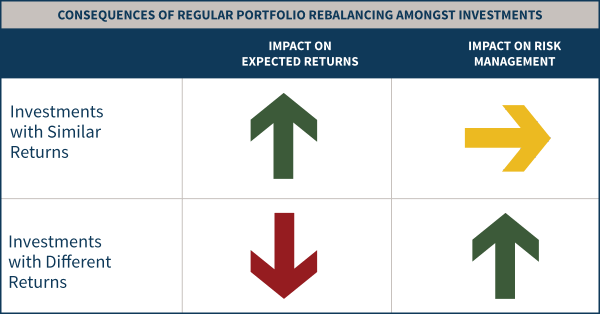 As we close in on the end of the year, it is a good time to take stock of your investment portfolio. If you haven’t already, you should consider rebalancing your portfolio back towards your target asset allocation. Overall, this means selling your recent winners and buying more of your recent losers.
As we close in on the end of the year, it is a good time to take stock of your investment portfolio. If you haven’t already, you should consider rebalancing your portfolio back towards your target asset allocation. Overall, this means selling your recent winners and buying more of your recent losers.
Now, you may think that rebalancing will improve your returns because you are “selling high” and “buying low”. However, the full picture is a bit more nuanced than that. If you think about it, the asset classes with the highest returns should eventually take over the portfolio if you never rebalance. If you started in 1965 with 50% stocks and 50% bonds and did nothing to 50 years, your portfolio in 2015 would have been overwhelmingly stocks. If you kept selling stocks and buying bonds, you would have probably lowered your returns in the long run. So why rebalance?

In his post How Portfolio Rebalancing Usually Reduces Long-Term Returns (But Is Good Risk Management Anyway), Michael Kitces provide a handy visual to summarize the effect of rebalancing into two scenarios:
- When rebalancing between asset classes with similar returns, the likely effect is to help increase your overall returns while not affecting your risk. An example is rebalancing between US and International stocks.
- When rebalancing between asset classes with different returns, the likely effect is to help lower your overall risk (improving your risk management in the chart) while decreasing your overall return. An example is rebalancing between stocks and bonds.
In the end, Kitces reminds us while your overall returns probably won’t be enhanced, the net effect of rebalancing is better risk management. I think of it similarly as preventing my portfolio from getting “out of control”. This is why people create “rebalancing bands” that let their portfolios wander a bit but not too much. For example, a 20% target allocation can vary from 15% to 25% before being rebalanced back towards the target number.
 The Best Credit Card Bonus Offers – March 2024
The Best Credit Card Bonus Offers – March 2024 Big List of Free Stocks from Brokerage Apps
Big List of Free Stocks from Brokerage Apps Best Interest Rates on Cash - March 2024
Best Interest Rates on Cash - March 2024 Free Credit Scores x 3 + Free Credit Monitoring
Free Credit Scores x 3 + Free Credit Monitoring Best No Fee 0% APR Balance Transfer Offers
Best No Fee 0% APR Balance Transfer Offers Little-Known Cellular Data Plans That Can Save Big Money
Little-Known Cellular Data Plans That Can Save Big Money How To Haggle Your Cable or Direct TV Bill
How To Haggle Your Cable or Direct TV Bill Big List of Free Consumer Data Reports (Credit, Rent, Work)
Big List of Free Consumer Data Reports (Credit, Rent, Work)
I just went through a re-balancing myself in mid December. I try to do this quarterly and find that it keeps my portfolio from getting too over-weighted in any one direction. Rather than selling winners, I typically put more of my focus on deploying new money towards asset classes that have not performed as well in the recent past. The hope is that I’m thus buying these stocks “on sale”.